

Inspire
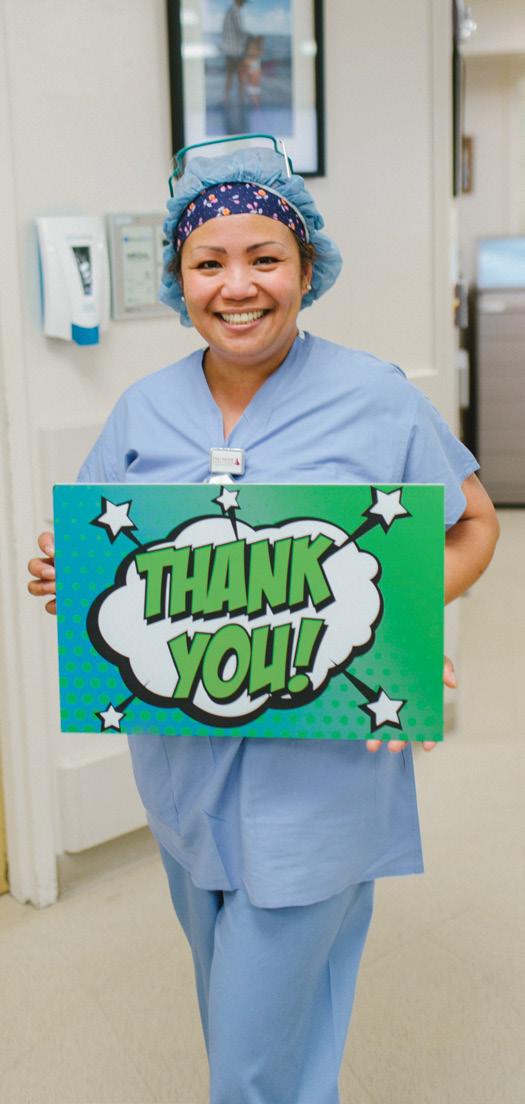
MESSAGE FROM SENIOR VICE PRESIDENT DAWN DUNBAR

Dear Friends of Hawai‘i Pacific Health,
Many people desire to leave their legacy in the world. Whatever their passions in life – from philanthropy to family – a legacy reflects these personal values. In Hawai‘i, we take much pride in teaching our familial history and values to our descendants. Charitable values that are passed down can build an intentional legacy that will bring about change in our community and inspire our families for generations to come.
Family philanthropy is beautifully demonstrated by the Wilcox family. Recently, we received a gift from the descendants of George Norton Wilcox. George was a successful entrepreneur who established a trust fund that would give back to the community, including public health. George felt a deep connection to Kaua‘i and his commitment to the island would set an example for future generations.
George envisioned a community hospital for Kaua‘i, and after his death, George’s family decided to transform his dream into reality by building a hospital in his honor. The 94-bed G.N. Wilcox Memorial Hospital opened in 1938, funded by the trust’s gift of $200,000. Since its opening, Wilcox Medical Center has been at the forefront of innovation, such as pioneering an X-ray program for early identification of tuberculosis, and becoming the first neighbor island facility to obtain a Level III Trauma designation.
Last year, November 1, 2018 marked Wilcox Medical Center’s 80th anniversary and the Wilcox descendants celebrated the milestone with a major gift. Providing great health care at Hawai‘i Pacific Health’s medical centers is our calling, and the Wilcox family has supported our work through decades. We are inspired and thankful for their spirit of giving, and for passing it on to the next generation, leaving a legacy that continues to serve our community.
Mahalo for touching the lives of our patients with your gifts!
With gratitude,

Dawn M. Dunbar Senior Vice President, Philanthropy
YOUR GIFT, YOUR IMPACT
Every gift makes an impact and this year Hawai‘i Pacific Health employees truly embraced the spirit of philanthropy. Here are some of the patient stories that inspired employees to give this year.
Pali Momi Medical Center
Trauma and Emergency Care Fund
Phamacist Ron Ishikawa felt a burning pain in his chest while driving to work at Pali Momi Medical Center. Upon his arrival, his co-workers in the Emergency Department quickly determined his arteries were completely blocked. Blood flow wasn’t getting to his brain. He was having a heart attack. Ron was rushed to the Pali Momi Catheterization Lab, where they cleared the blockage. “I have to thank Pali Momi for that vision of bringing this kind of service to this side of the island,” Ron said. “I didn’t understand how valuable the cath lab was. If Pali Momi wasn’t here, I probably wouldn’t be either.”
Wilcox Medical Center
Emergency Department and Trauma Services
Jay and Jeanette Gonzalez, both nurses, have worked at Wilcox since 2000. While exercising one day, Jay felt pressure and pain in his chest. Tests at Wilcox’s Emergency Department revealed that Jay was having a heart attack. The Wilcox emergency team contacted Straub’s cardiology team on O‘ahu and arranged for Jay to undergo a procedure at Straub’s cath lab. Today, he’s back to enjoying life with his three young children and receiving follow-up care at Wilcox. “Words are not enough,” Jeanette said. “That’s why we are so proud and grateful to work with the team at Wilcox.”
Kapi‘olani Medical Center for Women & Children
New Pediatric Heart Center
Straub Medical Center
K kua Fund
Mike was houseless when complications from diabetes sent him to Straub. His relationship with the medical center soon affected all aspects of his life. The K kua Fund, an emergency assistance fund for patients, paid for reading glasses, clothing and much more. “I would give anything to avoid going back on the streets,” Mike said. “I tell this to all of my friends, ‘My worst day today is better than my best day out there.’ Just by staying around positive people from Straub Social Services, it gives me a positive feeling about myself.”
Kayley Coloma gave birth unexpectedly after doctors determined her baby’s heart was beating too fast. She had to deliver early. Her daughter, Leila Rose, was admitted to Kapi‘olani’s Neonatal Intensive Care Unit where she was diagnosed with two congenital heart defects. At 5 months old, Leila Rose flew to the mainland for open-heart surgery. To this day, the 2-year-old receives ongoing heart care at Kapi‘olani. “Having a cardiac cath lab at Kapi‘olani would totally change the game for Hawai‘i,” Kayley said. “I think it’s so important that we have all the means to treat the kids here.”
2019Employee Giving Campaign!
The Hawai‘i Pacific Health ‘ohana went all aboard the ocean adventure-themed 2019 Employee Giving Campaign (EGC) which raised $1,114,489 for patients and their families. This is the third straight year that employee contributions have surpassed $1 million to support vital programs and services at our medical centers. HPH’s 18th annual campaign was the most successful ever!

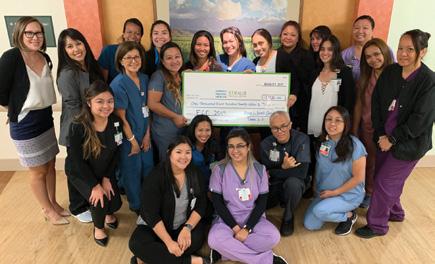
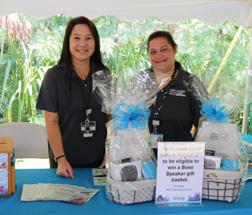

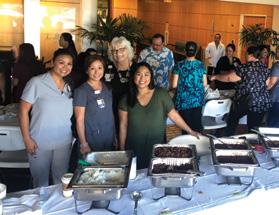
1 Kapi'olani's Pediatric Intensive Care Unit hosted a Chow Down fundraiser with an incredible assortment of homemade treats. 2 Straub's Bone and Joint team presented the proceeds from their delicious bake sale. 3 The Wilcox Health Foundation team set-up an EGC photo and information booth at the Wilcox employee carnival. 4 The HPH Human Resources team fundraised by selling affogatos, the classic espresso and ice cream dessert. 5 Pali Momi held an amazing Chili Cook-Off contest for the Trauma and Emergency Care Fund.
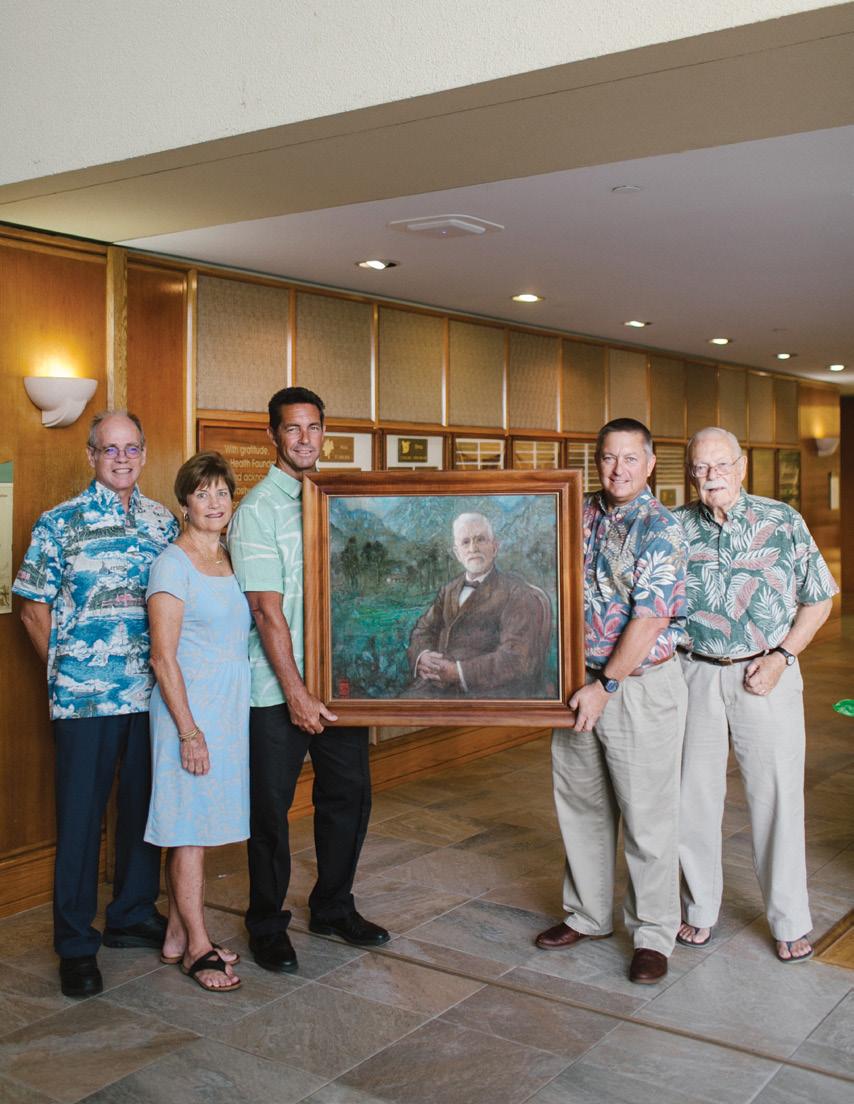
Wilcox family members with the portrait of G.N. Wilcox that hangs in the Wilcox Medical Center lobby.
All in the Family
Wilcox Medical Center is deeply rooted on Kaua‘i and in the history of the Wilcox family.
“OFTENTIMES WE’LL MEET PEOPLE WHO ASK ‘HOW LONG HAVE YOU BEEN HERE [on Kaua‘i]?,’ said Sam Pratt, a member of the Wilcox family and president of the Grove Farm Museum. “Then when I begin to tell the story, they find it interesting to meet someone who is actually part of that. It’s fun to talk about.”
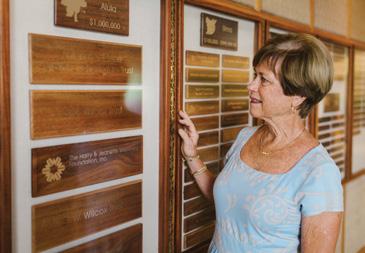
The story begins with George Norton Wilcox who was the first Wilcox born in Hawai‘i in 1839. His parents, Lucy and Abner, were missionary school teachers who settled in Hanalei. “They found a way to stay here and help the community,” Sam said.
Uncle George, as he’s fondly referred to by the family, grew up speaking Hawaiian and English. His commitment to those around him would set an example for generations to come. The successful entrepreneur established a trust fund to help advance public health. Then after his death, George’s family decided to build a hospital in his honor. The 94-bed G.N. Wilcox Memorial Hospital opened in 1938, funded by the family trust’s gift
of $200,000. George’s niece, Mabel, was pivotal in establishing the facility. She was a nurse who served with the Red Cross during World War I before returning home with a passion to improve health care for everyone in Hawai‘i.
Mabel was the great aunt of Dr. Richard Goodale who practiced with the Kaua‘i Medical Clinic for 33 years. The clinic is part of what is known today as Wilcox Health. He knew she was also a pioneer in local medicine, but he didn’t realize how closely he was following in her footsteps. “It happened that the college I went to was the college she graduated
from in nursing in 1911,” Dr. Goodale said. “[When I was applying], one of the questions on the Johns Hopkins University application was ‘Has a relative been here?’ and I put ‘no.’ I didn't know. Then after I got accepted and she found out, she was thrilled.”
Mabel passed away while Dr. Goodale was in college, but he’d carry on the family legacy at the medical center she helped create.
Dr. Goodale’s sister, Kathy Richardson, also found her place at Wilcox Medical Center. She ran the gift shop from 1986 to 2014. “We made it a gift shop that carried things that nobody else on Kaua‘i did,” Kathy said. “We went out of our way to create a unique shop with everything from clothing to artwork, homemade goods and baby things.” And every purchase added up to support patient care. “Every year between the gift shop and thrift shop, we would give over $100,000 to the hospital to purchase needed equipment.”
Wilcox descendant Kathy Richardson with the G.N. Wilcox Trust plaque.
The gift shop was another family affair. Edie Wilcox, Mabel's niece, also worked in the shop with her daughter, Deborah Wilcox Pratt. Deborah's son, Bill, remembers growing up playing there. It was such a big part of Deborah's life that her family (David, Sam and Bill) later made a donation to name it after her. “We lost our mother to cancer when I was 17,” Bill said. “I distinctly remember a telephone conversation when she was in the medical center, the night before she died, and she said, ‘This is where I'm from, I don’t want to be anywhere else.’ That’s why it’s extremely personal and important to us to support this type of development of acute care so that people don’t have to leave [the island].”
Kelley Carswell feels the same way. Her mother Gale, a Wilcox descendant,
“I can’t imagine that
those
involved from the beginning could have
imagined what
Wilcox Medical
Center is today. It has come so far in technology
and
treatment.
It’s rewarding to know that our family had an opportunity to play a part in that work."
SAM PRATT
LEFT TO RIGHT: Wilcox Health Foundation Director Andy Bestwick; David Pratt; Kathy Richardson; Bill Pratt; Sam Pratt; Dr. Richard Goodale; Wilcox CEO Jen Chahanovich. These Wilcox family members, and Kelley Carswell and family (not pictured) made a combined gift of $125,000 to the 80 th Anniversary Campaign.

recently passed away. The loss has raised her awareness of health care on Kaua‘i and what it meant to her mom. “She saw the progression over time and was very proud of the improvements in health care here,” said Kelley, who is a registered nurse. Kelley and the Carswell family, the Pratt family, Dr. Goodale and Kathy Richardson are all Wilcox descendants who are contributing to the Wilcox 80th Anniversary campaign to fund emergency care and expand trauma services. “The majority of people come through the emergency room and people are definitely going to need it at some point," Kelley said. "So improving its space or capabilities is just huge.”
For the Wilcox ‘ohana, supporting the hospital comes in many forms, from major gifts to leadership roles. A Wilcox family member has actively served on the hospital or foundation board ever since the hospital opened more than 80 years ago. David Pratt, husband of the late Deborah Wilcox Pratt, was the hospital board chair for 20 years and directly affected Wilcox’s future planning. “For the merger of the clinic and the hospital, which took about five years to negotiate, we had to bring all the doctors together,” David said. “The big capital campaign for a major expansion was a $20 million project that led to a three-story building that included additional long-term care beds. I also started the conversations to join Kap‘iolani Medical Center [now Hawai‘i Pacific Health], which they finalized when I retired. It was a good move.”
“I can’t imagine that those involved from the beginning could have imagined what Wilcox Medical Center is today,” Sam said. “It has come so far in technology and treatment. It’s rewarding to know that our family had an opportunity to play a part in that work.” The work is not over. But fortunately, it seems philanthropy, service and a passion for upholding the health of the community run in the Wilcox family. And for this, generations of Kaua‘i families are grateful.
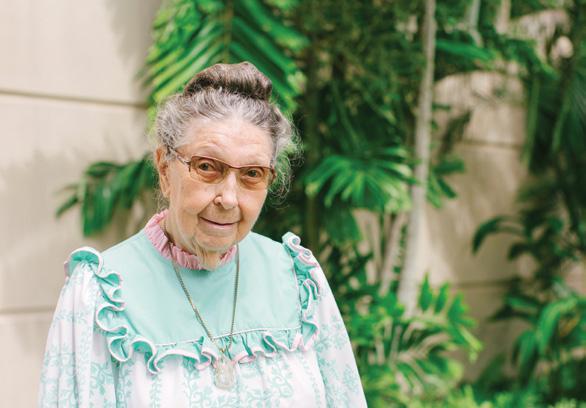

Honoring Betty Bell
An advertisement in a magazine led Betty Bell to Wilcox Medical Center. The rest is history.
BETTY WAS RUNNING A PHARMACY IN INDIANA WHEN SHE SAW THE JOB LISTING FOR A PHARMACIST ON KAUA‘I. “Being footloose and fancy-shirt free, I decided that I would apply and I was accepted,” Betty said. Two weeks later, she was on a plane for the Islands.
When Betty arrived in 1966, she did more than fill a position — she became the first pharmacist on Kaua‘i. She immediately worked to have the pharmacy licensed by the state. Betty also hired employees fluent in Filipino and Japanese to translate the English-only medicine instructions for non-English speakers.
“It was quite a change of environment,” Betty said. “I was not accustomed to these medical plans that had been provided to the population by the plantations. The doctor’s offices were directly dispensing medicine. I had to remind the doctors how to write prescriptions again.”
Soon the community adapted. Next, Betty started to look at the internal workflow. She created a new procedure, called the unit dose system, to increase efficiency and reduce medication errors. Physicians were required to fill out a detailed prescription order that went to the pharmacy, nurses and the billing office. In addition, each patient had a personalized drug profile that outlined what medications they needed.
Another of Betty's innovations was the medicine cart. It had a small tray for each patient that held his
or her prescriptions, physician orders and any other important information from the other forms. This new process saved time and eliminated unnecessary extra checks and questions. “We had carts on each floor and the pharmacy only needed to fill those carts about every three days for the nurse deliveries,” Betty said. It was so successful that it soon became standard procedure for the state pharmacy system in the ‘70s and was even adopted by hospitals across the nation.
From 1975 to 1980, Betty took on a leadership role as CEO for Wilcox. During her time in charge, she created an investment opportunity for Wilcox that also benefitted seniors. “We had a problem with patients who could no longer be taken care of by their family and I wanted to find an alternative for the elderly besides institutionalization,” Betty said. She helped transform 9.3 acres behind the medical center into a retirement complex known today as Sun Village.
“It worked out quite well and certainly proved a service because there really wasn’t anything else available at that time,” she said.
Wilcox Health Foundation has named Betty the honorary chair of the 80 th Anniversary Campaign. It’s an acknowledgement for a woman who came to Kaua‘i by chance, and fortunately for Wilcox, was driven to improve things for others.
Betty Bell in 1978.

Education Game Changer
ETHAN
KANESHIRO LIVES FOR SOCCER. The 10-yearold doesn’t let anything stop him from his favorite game. Even when new soccer shoes left him with blisters, he kept going. But a few days later, he began to feel sick.
“We thought he had the flu because he had a fever, but then he complained about how his heel hurt,” said Joy Kaneshiro, Ethan’s mom.
Ethan had a fever and persisting pain in his heel for a week. A pediatric orthopedist referred him to Kapi‘olani Medical Center for Women & Children for an MRI. The results revealed something far more serious. Bacteria had gotten through his blisters into his blood, causing a staph infection that invaded his bone. Ethan was immediately admitted for a biopsy. He was in the hospital on antibiotics for 12 days.
“It was my first time staying in the hospital and sleeping in a place away from home where my family was,” Ethan said. “I was a little scared.”
Ethan soon found a way to feel comfortable at Kapi‘olani. He started going to Brain Station, a school away from school for kids in the hospital that is a part of Educational Services. In classes, he was able to feel normal again.
“What Ethan really enjoyed about Brain Station most was being around the kids and earning points for showing up, doing the assignment or activity,”
Joy said. “It’s somewhere he could go and it didn’t feel like he was just there in a room getting medical treatment.”
Brain Station started as a summer school program in 2015, initiated by Dr. Carrie Shiraki-Sakaino who has been a teacher, counselor and student services coordinator for more than 25 years with the Hawai‘i State Department of Education. Now, it’s a permanent program that doctors can request to help inspire young patients, both mentally and physically. Some lessons come from actual assignments from local schools. Dr. Shiraki-Sakaino, who is certified in cognitive rehabilitation, also creates daily curriculums with specific purposes. For example, on Thursdays, kids engage in math and science.
Both subjects are connected to social and emotional well-being. The rest of the week, they may work on other topics that enhance memory, speech or language, or other mental skills. And sometimes, it is the doctors who learn something from the experience.
“It provides a lot of insights to the physicians in terms of how patients are operating,” Dr. Shiraki-Sakaino said. “In medical rounds, a doctor may say ‘seems like the patient’s thought process is a little bit confused and that their right hand is weak.’ And I respond, in Brain Station the patient is absolutely fine, answering questions and writing with no problem.”
Brain Station can be factored into treatment plans, something that can be pivotal for students who are in the hospital for years. Tutors assist kids as

Dr. Carrie Shiraki-Sakaino with her students who are Kapi‘olani patients attending Brain Station.
Dane, Ethan (Kapi‘olani patient), Lia and Owen Kaneshiro are siblings who all play for Hawai‘i Rush Soccer Club.
young as 5 to college-aged students. The program is also not just for patients; the class time is a valuable break for parents.
“One parent who was at Kapi‘olani for a long time described it as her ‘respite time’ to go do her workout, which then gave her the energy to continue for the rest of the day,” Dr. ShirakiSakaino said.
Learning can also prove to be a treat for the kids. In the Reading Expedition Program, students receive treasure rewards for every 15 minutes of reading. They also enjoy brain bucks, which are colorful chips earned by attending class, completing assignments or engaging in activities. The brain bucks can be used to shop at the school store for toys, books and gift cards.
“If some patients, especially our teens, don't see anything in this store that they want, I ask them ‘What would you like?’ and all of a sudden it shows up in the store,” Dr. Shiraki-Sakaino said. “That's why we really value the donations to the Brain Station, to be able to purchase items for our students that they want because it motivates them to show up.”
It can also be empowering for kids to purchase something for someone in their family or a new friend.
“I gave my chips away because it was my last day and it was someone's birthday, so I gave it to them so they could buy something better,” Ethan said.
Ethan’s team, Hawai‘i Rush Soccer Club, was so touched by his care at Kapi‘olani that the club donated $3,000 in his honor to Brain Station. Donations from individuals and organizations like American Savings Bank, Island Insurance Foundation and Pacxa have been instrumental
in purchasing school supplies and laptops. Gifts also funded a robot that can remotely connect bedridden patients to class.
Next on the fundraising wish list are a dedicated classroom space and a full-time teacher who can work year-round at Brain Station. The program currently depends on volunteers and part-time tutors, and is held in a classroom near the Kapi‘olani playroom. Despite its small beginnings, the program has garnered national attention.
“Huge hospitals on the mainland are trying to replicate what we do here.”
DR. SHIRAKISAKAINO
“What's really amazing is that I was able to present Brain Station twice for national audiences,” Dr. Shiraki-Sakaino said.
“Huge hospitals on the mainland are trying to replicate what we do here.”
Today, Ethan’s back to his normal routine on the soccer field. But his fond memories of Kapi‘olani and the Brain Station show the experience is a real game changer.
“It's just like having friends at school or being at my house. I can be like myself and not have to be worried about what could happen in the hospital,” Ethan said. “Thank you for making me feel at home.”

Ethan's team, Hawai'i Rush Soccer Club, donated $3,000 to Brain Station in his honor. From left to right: Megan Yee (Child Life Specialist), Ethan, Joy and Darren Kaneshiro, and Arian Hoxha (Technical Director of Hawai'i Rush Soccer Club).
Crafting Camaraderie
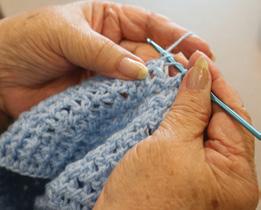
YOU'VE PROBABLY SEEN THEM IN FIRST BABY PHOTOS.
Tiny, colorful crochet beanies that are given as a gift to every newborn at Kapi‘olani Medical Center for Women & Children. Each small memento is a big production. Hundreds are created every year, stitch by stitch, by volunteer crafters.
“It feels really gratifying to know that the babies are all wearing the beanies that we made,” said volunteer Sally Okimoto. Sally and her friend, JoAnn Akashi, drive in once a month with fellow Mililani friends to continue their caring
work at the hospital.
“I was interested in knitting because I have a 12-yearold granddaughter who was here at the neonatal intensive care unit. She was a preemie,” JoAnne said as tears welled up in her eyes. “We saw her go through this whole thing.”
Every volunteer has his or her own reason for giving back. Renni Ho encouraged her mother, Nancy Miura, to knit for Kapi‘olani after they lost Nancy’s husband, Renni’s father.
“I thought it would be good for the grieving process for my mother to crochet something positive,” Renni said. “It’s given her purpose. My mom’s turning 90 and we’ve been coming since 2011.”
Some take up the hobby after retiring, while others attend for the socializing that comes when trading patterns. But all feel welcome because the only requirement to join is being willing to learn.

The dedication of the group is impressive. Alma Yee of Pacific Heights, 93, has been creating patient keepsakes for 33 years. Geri Nomura recently retired from the state Department of Taxation and Department of Labor, where she and her co-workers knitted caps during their lunch breaks for two years. Another very passionate knitter is Mary Souza. She’s dedicated two decades to the cause and has even mastered holiday hats.
“There was a lady that said she remembers a hat I made for the Fourth of July, and she still had it,” Mary said. “I have heard of people framing the baby hats, which is nice because it's something they can keep forever.”
This crafting group does more than baby beanies. They crochet blankets, scarves and hats for children and adults being treated for cancer. For Mary, who recently completed her own cancer treatment, these projects are personal.
“It's a good feeling,” Mary said.

Some of the most dedicated crafters are (left to right) 93-year-old Alma Yee, 89-yearold Eleanor Chun and 91-year-old Frances Ma.
Kapi‘olani crafters who carpool together from Mililani, including JoAnn Akashi and Sally Okimoto.
Stop the Bleed
A medical emergency can occur in an instant. How quickly a person receives aid can be pivotal to his or her survival.

Field supervisor Mika Pokaka‘a and warehouse manager Lawrence Miyazono learn how to pack a wound during Stop the Bleed training for D. Suehiro Electric employees.
IN ACCIDENTS OR TRAUMA, THE TOP PREVENTABLE CAUSE OF DEATH IS UNCONTROLLED BLEEDING. In those key moments, bystanders can quickly become lifesavers with training from the Stop the Bleed initiative at Pali Momi Medical Center.
“Stop the Bleed training takes about an hour and anyone can do it,” said Matt Wells, a registered nurse and trauma program manager at Pali Momi. “I’ve had people say after class that nothing about the training was difficult and that the potential to help someone stay alive has changed their mentality of never wanting to get involved.”
People learn about the different kinds of medical emergencies and types of wounds that would need treatment. Then, health experts teach them how to respond by applying direct pressure, tying a tourniquet and packing the wound. Every participant gets hands-on experience by practicing on others and using open-wound simulators.
These are valuable skills. An estimated 30% of the people who die from traumatic hemorrhage could have been saved if someone had been able to keep them from bleeding out.

“Not all bleeding is caused by acts of violence,” Matt said. “It can be caused by kitchen accidents, workplace injuries, and many other things that we do that put us in danger, from heavy equipment to sharp objects in our environment.”
Recently, Matt trained more than a dozen employees from D. Suehiro Electric in Stop the Bleed techniques. Safety is part of the company culture, with team members there being offered training in everything from first aid to CPR.
“The only exposure I've really gotten on this is through movies,” said Kehau Yokoi, project estimator for D. Suehiro Electric. “You see the Hollywood version of someone being dramatically saved with a tourniquet. Now I know what to do. If I ever get in this situation, I’ll remember learning this.”
“I could see how this will help in the field for work and in life because accidents can happen anywhere,” said Mika Pokaka‘a, field superintendent for D. Suehiro Electric. “If you're prepared and you have training, you feel a little more comfortable doing it.”
Matt Wells works with journeyman electricians Blaine Umeda (left) and Bobby Pagdilao (right) to answer questions and demonstrate tourniquet techniques.
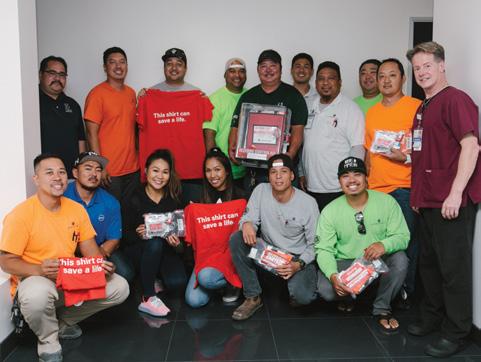
multiple packs of tourniquets, gauze, gloves and trauma dressings. Many times Stop the Bleed kits are mounted on a wall near an AED (automated external defibrillator) to create an Emergency Response Station.
"While we hope that no one has to use these training techniques and supplies, we believe that it's a matter of when, and not if, they could save someone’s life,” Matt said. “Providing this training and equipment to people across our state will lead to lives being saved in the event of a natural or man-made emergency."
“While we hope that no one has to use these training techniques and supplies, we believe that it's a matter of when, and not if, they could save someone’s life. Providing this training and equipment to people across our state will lead to lives being saved in the event of a natural or man-made emergency.”
MATT WELLS, REGISTERED NURSE & TRAUMA PROGRAM MANAGER AT PALI MOMI
D. Suehiro Electric is not only encouraging employees to participate, it is giving back so more people can learn these lifesaving skills. A company donation has enabled Pali Momi to offer Stop the Bleed classes to more than 1,000 people so far. Matt manages the free Stop the Bleed classes along with Pali Momi Trauma Medical Director Dr. Maria Ver, Trauma Program Specialist Rachel Ropke and other trauma surgeons. They’ve worked with employees from Aloha Stadium, Stan Sheriff Center, the city’s Department of Emergency Management, and Honolulu Zoo, as well as faculty and students from several high schools.
Pali Momi Foundation also donates Stop the Bleed kits, which contain
The Stop the Bleed program began in 2015 as a public safety initiative adopted by former first lady Michelle Obama. Trauma centers across Hawai‘i adopted it as a collaborative effort two years later, with Matt as the statewide coordinator, but after some time funding ran out. Fortunately, Pali Momi was able to continue this valuable program through donations to the Pali Momi Foundation. Today, the free classes are still available for anyone who wants to learn the lifesaving techniques.
“Safety is a top priority for our team of 60 employees, both professionally and personally,” said Daryl Suehiro, president of D. Suehiro Electric. "We are honored to fund Stop the Bleed at Pali Momi in order to keep this valuable program alive, it empowers the people who are trained and benefits everyone."
D. Suehiro Electric employees who participated in the Stop the Bleed class with Matt Wells (right).
Handmade Comfort Touches
At Pali Momi Medical Center, sometimes comfort comes in the form of a blanket.

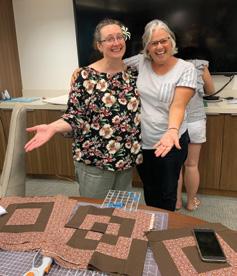
FOR PATIENTS FACING SERIOUS OR EVEN TERMINAL MEDICAL CONDITIONS, soft and colorful handmade blankets are a gift to help ease their worries and make them feel more at home. And it all comes from the hearts and hands of volunteers.
Crafter Jeanette Kaneshiro came up with the idea that turned into Pali Momi's Blankets from the Heart program. The Palliative Care team offers it as an extension of care for patients and their families.
Emergency physician Dr. Lily Gallagher is a quilter herself. She took leadership of the program in 2018 after she made a quilt for the Pali Momi Art Exhibit. “It started
out as an individual project with a quilt I donated, but I began to wonder how I could expand this project by engaging the HPH community,” Dr. Gallagher said. “It also gave me the chance to teach and share my quilting passion for a good cause.”
One of her ideas was to create a sewing club. Volunteers and staff members from across the Hawai‘i Pacific Health system meet quarterly to design, cut, piece, quilt and bind the blankets.
“No two blankets are the same and family members go home with a handmade quilt that provided warmth and comfort to their loved ones,” Dr. Gallagher said. “The
volunteers have expressed how good it feels to make something so personal and unique from beginning to end.”
Recently, the program expanded to include handmade chemo port seatbelt pillows that are given to patients at the cancer center. These special pillows attach to a seatbelt to help protect the small port beneath the skin where patients get their chemotherapy. Every project is funded by community contributions and offers a bit of love and care for those who need it most.
Sewing club for Blankets from the Heart program at Pali Momi Medical Center.
Jamie Sharpe (left), palliative care nurse practitioner at Kapi‘olani Medical Center for Women & Children and Jody Barnhart (right), mother of Dr. Kersten Milligan, emergency physician at Pali Momi Medical Center.

Dan Moynihan stays in Hawai‘i during certain times of the year because the warmer weather eases his medical conditions.
Caring for a Hero
Life in Hawai‘i and across America changed forever on the morning of September 11, 2001. This is especially true for the families and friends of those who were lost and the first responders who rushed to the scene of the attacks at the World Trade Center.
ON THAT HORRIFIC DAY DAN MOYNIHAN, WAS A NEW YORK CITY FIREFIGHTER. Dan was enjoying his day off when he and a fellow firefighter heard about the attack and immediately jumped into action. The destruction shut down most of the city and closed roads, but Dan was able to catch a ride to Ground Zero in a pickup truck carrying three other firefighters.
“I walked one block down and remember a jet engine from a plane sitting on the corner,” Dan said. “The air was pitch black and the dust was so thick that it kind of looked like snow. That’s when I realized the north tower and south tower [of the World Trade Center] collapsed.”
Dan worked for a month straight at Ground Zero amongst the rubble and ruins of the 110-story towers — all the while inhaling powdered debris into his lungs. Soon after, Dan developed chronic
lymphoproliferative disorders, asthma, trouble exhaling and post-traumatic stress disorder, among other conditions. But one of the most physically painful problems was cluster headaches.
The headaches were severe and sudden, often sending Dan to the emergency department. The condition requires a specific treatment regimen and a group of supportive health care providers. Dan found both at Straub Medical Center.
Dan’s husband, Jarret, was born and raised in Hawai‘i. The islands have become a second home because the mild weather eases Dan's symptoms. But as he travels between New York and Hawai‘i, Dan carries a binder holding his medical history and doctors’ notes about his treatment, in case he ever becomes too debilitated to explain the complexities.
It is a necessary precaution. Dan has been admitted to Straub’s Emergency
Department four times. The team there has helped him with compassion and care. Straub’s staff has come to understand Dan’s specific needs when a cluster headache hits, which sometimes requires a quiet and dark isolation room to relieve his pain. Dan also checks in regularly with Straub Neurologist Dr. Brandon Hirota. “Dr. Hirota really puts you at ease and his staff is amazing,” he said. “Dr. Hirota knows all this stuff inside and out and he knows how to treat it.”
Dr. Hirota says cluster headaches are not very common but tend to affect men. The condition often causes involuntary body functions including tearing, eye redness and nasal discharge. The pain is typically quite severe and usually occurs on one half of the face. “As the name suggests, this type of headache disorder is usually characterized

by a ‘cluster’ or run of headaches that may last days to months,” Dr. Hirota said. “Dan’s treatment protocol is quite complicated. In actuality, he is being followed for a total of four different headache disorders, each with its own treatment regimen. I view us as his safety net. If his treatment regimen is not working, we are ready to step in and help out.”
And Dan’s Straub team is expanding. When he began feeling persistent pain in his knees, husband Jarret recommended his classmate Dr. Cass Nakasone. The Straub orthopedic surgeon performed robotic knee surgery on Dan. “The first week, I was already on the walker bearing a little bit of weight and by the middle of the second week, I couldn’t wait to get rid of the walker,” Dan said. “Between Dr. Nakasone and my physical therapist, it’s phenomenal.
“I view us as his safety net. If his treatment regimen is not working, we are ready to step in and help out.”
DR. BRANDON HIROTA, NEUROLOGIST AT STRAUB
I’m having the other knee done next year!” He’s even seeking a primary care physician for regular checkups.
All of the pain and challenges Dan continues to struggle with have inspired the firefighter to help others through legislation. He often travels to Washington, D.C., to advocate for veterans’ bills, as well as for health and compensation for the first responders who found themselves on the front lines of one of our nation’s biggest tragedies.
“One thing I ask people to know is that we did our best to get everybody back to their families,” Dan said. “We did our best to get everybody out of the buildings. We treated every set of remains with the highest amount of respect. We tried our best to get everybody and I just hope everybody knows that.”
Dan sharing a photo of him working at Ground Zero. He arrived to the scene in a shirt and shorts because it was his day off.
A Heartfelt Gift
The bond between a patient and doctor is key for care. But sometimes, that relationship becomes a lifelong friendship that goes beyond the exam room.
SUCH WAS THE CASE for Hans and Marie-Claire Strasser and the late Dr. Raymond Itagaki, a Straub Medical Center cardiologist.
Recently, Hans celebrated his 80th birthday. For his special day, Hans and Marie-Claire showed their gratitude with a gift to Straub of $100,000 in honor of their friend, Dr. Itagaki. Their generous gift will support the renovation and expansion of the Clarence T.C. Ching Heart Center’s cardiac catheterization labs.
“We are big fans of Straub and are indebted to my good old friend, Dr. Raymond Itagaki, who helped me, cared for me and worked on me,” Hans said. “I miss him very much.”
“The thing I will always remember about Dr. Itagaki is his patience and thoroughness,” Marie-Claire said. “When we sat in his office, Dr. Itagaki took the time to draw out this
beautiful illustration of a heart to explain how Hans’ heart was currently functioning (pictured below). We were so appreciative that, even as busy as he was, he took the time to sit with us, patiently explain everything, and even sketch a model with multiple colors to help us understand.”
Dr. Itagaki was a member of the first University of Hawai‘i John A. Burns School of Medicine graduating class of 1975, practiced cardiology in Hawai‘i for 35 years and was a valued member of the Straub ‘ohana. Throughout his storied career he touched many lives.
FROM LEFT TO RIGHT:
Straub COO Travis Clegg, Hans and Marie-Claire Strasser, Straub CEO Art Gladstone, and cardiologist Dr. Roy Chen.
Connie Itagaki, Raymond's widow, is touched by every gesture. “I am always grateful to hear of any gift in his memory, but to see a gift so significant is truly incredible,” Connie said. “Just the outpouring of everyone who gives makes me feel that he was truly loved, cherished and valued by his patients.”


Dr. Itagaki's heart illustration.

Jayven Alvarez-Hopkins and his mother Joanne in 2018.
The Wilcox Boys
OFTEN THERE ARE PATIENTS AND FAMILIES WHOSE STORIES AND PERSONALITIES LEAVE LASTING IMPRESSIONS on the staff at Kapi‘olani Medical Center for Women & Children. Such was the case with four young patients that the nurses named “The Wilcox Boys” because of the inseparable bond the boys formed during their hospital stay in the Wilcox ward.
Mahoe Dancel, Jr., 13; Bjorn Astrom, 8; Aidan Gadingan, 10; and Jayven Alvarez-Hopkins, 10, first met during their physical therapy sessions. Mahoe was admitted with a brain injury; Jayven with Guillain-Barré syndrome, a rare disorder that can lead to full-body paralysis; Bjorn with injuries from a car accident; and Aidan with meningitis. Each boy faced his own set of challenges. But soon, they were inseparable. The four first bonded over video games, Pokémon, sports and other shared interests. Within weeks, the foursome could be found in matching shirts and personalized hats playing hallway tag in their wheelchairs. “Having friends in the hospital made my time more fun,” Aidan said. “Jayven and I both like Pokémon and when he left Kapi‘olani, he gave me his tin of Pokémon cards.”

Their connection really helped the boys. Neighbor island families can feel isolated when they’re living away from home. Since two of the kids’ families live on the Big Island and one on Kaua‘i, they became each other’s support systems. “Out of something so devastating, we were able to form connections,” said Mahoe’s mom, Sharra. “The boys formed friendships, cheered each other on and when they had hard times, they pushed each other a little harder.”
During their more than 90-day hospital stay, the Wilcox Boys spent their time at various Kapi‘olani services including the Brain Station, rehabilitation activities, Child Life therapy and visits to the Playroom. All of these programs benefit from Children’s Miracle Network (CMN) donations.
“Bjorn and I played Mario Kart in the Playroom a lot,” Jayven said. The mobile game cart that was funded by gifts to the CMN Radiothon is fully loaded with an Xbox, television
Wilcox Boys during hospitalization when they became friends and required wheelchairs in 2018. Now they are all back to active lives. From left to right Aidan Gadingan, Mahoe Dancel, Jayven Alvarez-Hopkins and Bjorn Astrom.

before he was discharged.
monitor and a variety of games. The activities are not just for entertainment – they are also therapeutic. According to JoAnne, Jayven’s mom, her son was progressing from complete paralysis, and was able to regain use of his wrist, leg and thumbs to play video games.
The boys would also motivate each other to do their schoolwork in Brain Station. In the beginning, Jayven had limited hand mobility and Mahoe had limited speech. The two decided to work together on assignments — Mahoe turned the pages and Jayven read out loud. The foursome supported each other through every challenge. “When Aidan hit a setback in his treatment, Jayven and Mahoe visited him in the Pediatric Intensive Care Unit,” said Aidan’s mom, Rhonda.
The Wilcox Boys stay in touch to this day. “You can’t break a bond like this,” JoAnne said. “I never thought such an amazing experience would come from such a traumatic one. The staff really exceeded our expectations as families and what we need. They want you to feel like you're home because in a way they become your family.”
WHERE THEY ARE TODAY
THE BOYS ARE THRIVING IN THEIR INDIVIDUAL RECOVERY JOURNEYS. Aidan is home on Kaua‘i and back to doing the things he loves, such as video games, judo and wrestling. “He’s come a really long way in such a short amount of time,” dad Donovan said. “I was just so surprised how fast it took him to get back into training.” He’s back to regular workouts. “And I can even throw my dad at practice,” Aiden said.
Bjorn has transitioned smoothly to home and school life in Mililani. “In the hospital Bjorn was mostly using his wheelchair, but since he's been home he rarely uses it,” mom Theresa said. His family says Bjorn is walking and running with ease, and is even swimming. Theresa is proud to report, “Bjorn went from not being able to coordinate holding his breath underwater to snorkeling, floating and is now close to mastering his doggy paddle.“
Jayven is still playing video games, but recently achieved a major milestone in his recovery when he started to run again. “Jayven is doing so amazing. He is diving again, swimming and fishing,” JoAnne said. “His next goal for sports is to start playing football. As his mom I’m so scared, but he’s such a little go-getter, it’s hard to hold him back.”
Mahoe is home on the Big Island and getting stronger every day. He is back to bouncing on his trampoline and looks forward to going to the beach or the gym for strength training. Recently, Mahoe visited Kapi‘olani with the Genoa Keawe Foundation to help teach patients how to play the ‘ukulele. Mahoe’s message to his students was simple. “Just push yourself and try as hard as you can. Always keep going.”


LEFT: Mahoe visiting with Genoa Keawe Foundation. RIGHT: Aidan today with his parents.
Bjorn at a celebration party for all of the Wilcox Boys just
miracle moments

Lily’s School Surprise
LILY LYMAN, HAWAI‘I’S 2019
CHILDREN’S MIRACLE NETWORK CHAMPION, celebrated her ambassador year with a special school assembly. Children's Miracle Network (CMN) partners, Kapi‘olani Health Foundation board members and her Le Jardin Academy friends all came out to recognize her. Representatives from Costco Wholesale, Panda Express, Ace Hardware and Marriott's Ko Olina Beach Club surprised Lily with flowers and gifts. The remarkable 13-year-old survived brain cancer. Intense treatments resulted in severe hearing loss, but she continues to thrive with cochlear implants. “Lily’s story hits home for our ‘ohana and inspires our organization to continue to fundraise for kids like her,” said Jill Munas, director of activities at Marriott’s Ko Olina Beach Club.

Costco Wholesale Volunteer Spotlight
AMAZING PEOPLE HELP MAKE MIRACLES HAPPEN every day for Kapi‘olani Medical Center for Women & Children and Vince Hill is one of those incredible supporters. Vince began his career at Costco Hawai‘i Kai 25 years ago and he’s been a powerful advocate for Children’s Miracle Network. In 2005, he launched a letter-writing campaign and handed out nearly 1,000 letters about upcoming fundraisers to customers at Costco in just 30 days. On his own, Vince organized the first “Miracle May Concert Series” in 2008 that featured local musicians, an event that is still going strong today. Vince is also known for his delicious home-baked tarts, cookies and cheesecake bites that he sells to raise funds for CMN. Vince retired at the end of 2018, and Kapi‘olani is forever grateful for his efforts.
Aloha Pacific FCU
ALOHA PACIFIC FEDERAL CREDIT UNION (FCU) presented Kapi‘olani Medical Center for Women & Children with a generous donation raised through various employee bake sales and fundraisers.
The gift is part of Aloha Pacific FCU's continuous support for CMN. Employees also give their time as volunteers for the annual Radiothon for Kids and the company raises money throughout the year with special member-only CMN credit cards, which designate a portion of all cash-back purchases to Kapi‘olani. “Mahalo to Kapi‘olani Children’s Miracle Network and all the wonderful work you do for our island keiki,” said President and CEO Vince Otsuka. “Aloha Pacific FCU is honored to continue supporting such a worthy cause.”

Extra Life
EXTRA LIFE GAME DAY IS A 24-HOUR EVENT that brings individuals around the world together to play games in support of local Children’s Miracle Network Hospitals. Gamers ask for pledges, then play anything and everything from video games to board games. Last year, teams across Hawai‘i gathered at various locations, including The Armchair Adventurer, PC Gamerz Hawai‘i, and 4 Pillars Hobby Shop. To learn more or sign-up for Extra Life gaming opportunities during the year, visit Extra-Life.org.

Kapi‘olani Radiothon for Kids
Now in its 13th year, the Kapi‘olani Radiothon for Kids has raised the fundraising bar yet again. The Children’s Miracle Network Hospitals event, in partnership with KSSK (iHeart Radio), collected a record $300,138 for Kapi‘olani Medical Center for Women & Children. Individuals, organizations and sponsors statewide contributed critical funds to support the health and well-being of Hawai‘i’s children.

13th Annual
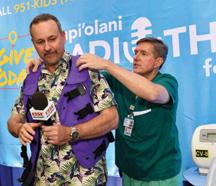
Danny Rausch (right), Kapi‘olani respiratory therapist, gave a demonstration of a specialty oscillation vest that is used in treatments for cystic fibrosis and other chronic diseases.
KSSK's Scotty B (left) had the chance to wear the vest and experience the mechanical compressions that a pediatric patient undergoing chest physical therapy would feel.
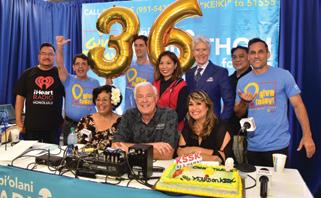
One of Radiothon’s hardest working volunteers, Michael W. Perry, had a milestone moment live on air. The day of the radiothon was the exact day 36 years ago that the legendary radio personality started with KSSK. Perry is also a pioneer for this event, as an original radio personality for the Radiothon for Kids since the event’s inaugural year in 2006.
“Each year is just as inspiring and emotional as the last. For two days a year we have the opportunity to meet the patients, the families, the staff at Kapi‘olani, and all the people who make this place so special 365 days a year. I feel lucky to have been a part of this fundraising effort from the beginning and proud to continue the tradition!”
MICHAEL W. PERRY, KSSK RADIO PERSONALITY
The
Radiothon for Kids raised a recordbreaking $300,138! The 2019 results bring the overall total amount raised to $2 million.

The presenting sponsor for the 2019 Radiothon for Kids was D. Suehiro Electric, Inc. This year marked the company’s third year participating. D. Suehiro Electric employees set a shift record by raising $37,310 for Kapi‘olani during their hour-and-a-half volunteer time on the phone bank. In addition, the company donated two fully stocked room decorating and comfort carts that will help celebrate the milestones and miracle moments patients experience.

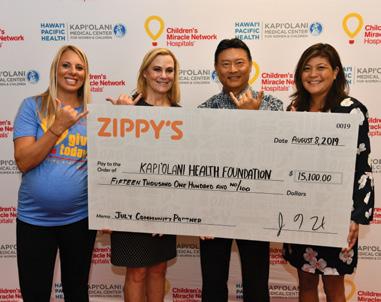
is
the
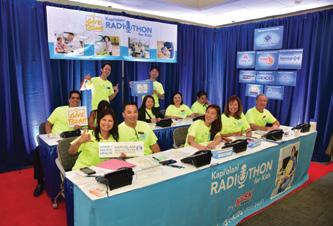
"Our guests, employees and their children have all benefited from Kapi‘olani, that's why we feel this partnership is so important. To be at the Radiothon for Kids amongst the excitement, the noise and all the phones ringing, really shows us how many people are involved."
PAUL YOKOTA, PRESIDENT OF ZIPPY’S RESTAURANTS
Perry and the Posse posing with Kapi‘olani patient Jericho after he shared his inspirational fight against cancer with KSSK listeners.
Pacific Guardian Life
a committed Radiothon partner. It's employees volunteered for
final hour of the event, and presented a $10,000 check after their phone bank shift.
The Radiothon is a trademark event that brings the community together. Kapi‘olani was honored to have returning sponsors, such as D. Suehiro Electric, HMSA, AlohaCare, and welcome new community partners like Zippy’s Restaurants.
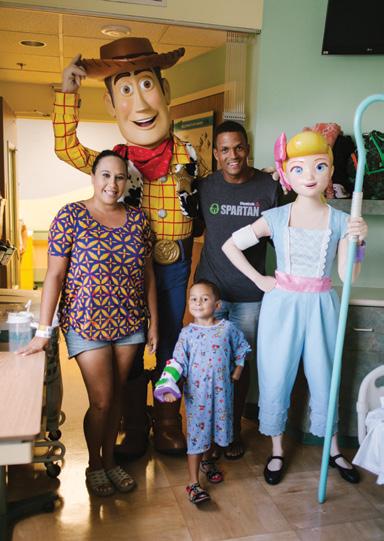

The Edwards 'ohana with Woody and Bo Peep during a Kapi‘olani patient room visit. Disneyland Resort Hotels' Elliot Mills (left) greeting Kapi'olani patient families at the Disney Team of Heroes party.
Magical Movie Moment
KAPI‘OLANI MEDICAL CENTER FOR WOMEN & CHILDREN WAS “A-BUZZ” WITH EXCITEMENT when Aulani, a Disney Resort & Spa, hosted a special Toy Story 4- themed party for patients. The party coincided with Aulani’s annual Disney Toy Delivery.
The donation is a part of Disney Team of Heroes, the company’s initiative to bring comfort and inspiration to kids facing serious
illness. The special gifts inspire play, reduce stress and bring a sense of normalcy in a difficult time.
The party for Kapi‘olani patients was filled with amazing moments, including interactive games, activities, prize drawings and a special viewing of Toy Story 4 in the medical center auditorium. Adding to the excitement, two very special visitors flew in for the celebration.
“We have Woody and Bo Peep from Toy Story 4, ” said Elliot Mills, vice president of hotel operations for Disneyland Resort
Hotels and Aulani. “The kids are enjoying it and we just feel happy that we were able to bring a little bit of joy and a little bit of laughter as they are going through their treatments.”
Woody and Bo Peep went roomto-room to meet keiki who could not join the festivities, bringing smiles with them. “I know Damian was feeling down at times, and then the staff told him that Woody might be coming, and he cheered up real quick,” said David Edwards, Damian’s father. “It was an awesome treat.”
The medical center is grateful to Aulani for hosting this unforgettable event. Its commitment to Kapi‘olani continues to bring a little bit of magic to patients and families year-round.
On the Cutter Edge
DID YOU KNOW that more than 6,200 babies are born at Kapi’olani Medical Center for Women & Children every year? As Hawai‘i’s most popular delivery destination, Kapi‘olani’s labor and delivery nurses are always busy caring for the medical center’s youngest patients and their moms. One of the nurses in the Family Birth Center, Pauline Cutter, goes beyond treating the patients — she’s helping to fund the care they receive.
Pauline joined Kapi‘olani in October 2008. She works closely with the staff to assess needs for the unit and then works with her husband’s family company, Cutter Automotive Galleries, to find a way to fulfill them.
“Our family is passionate about the care that Kapi’olani provides for
the mothers and children in our community,” Pauline said. “It’s a special place; my husband and I delivered our three boys there and never considered going elsewhere.”
The gifts Pauline helped secure have paid for equipment, including fetal monitors, and benefited the medical center’s antepartum and bereavement programs. Fetal monitors provide critical observations of a baby’s heart rate to help ensure safe delivery of high-risk pregnancies. The antepartum program allows high-risk moms-to-be and their babies to be closely monitored in a comfortable, nurturing environment. The bereavement

Pauline showing the antepartum program activities available to expecting mothers who are staying
program provides support and guidance to parents and family members dealing with the loss of a child.
“I wanted to ensure the donation would be utilized to its fullest potential,” Pauline said. “The antepartum program provides a relaxing and fun social outlet for our mothers who are high risk and are required to stay in the hospital until delivery. They form bonds at the tea socials and even learn how to crochet. Equally important is the necessity of a bereavement program for moms and families who are grieving.”
Pauline and Cutter Automotive Galleries have been donating to Kapi‘olani since 2014.

The Cutter family celebrating their new Volvo location in Honolulu with a blessing from Reverend Akaka in 2019.
at Kapi'olani.
Dr. Alson Inaba, Martha Smith and staff demonstrating the hands-only CPR dance.

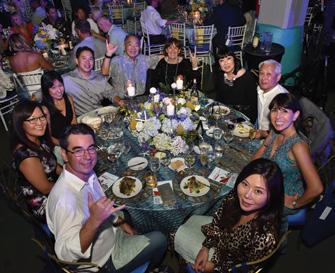
The Kobayashi Group attendees enjoying the
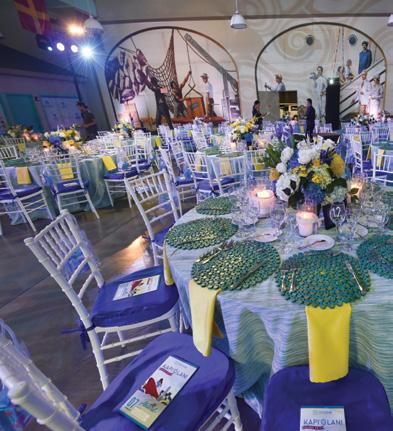

Soirée co-chairs Shelley Cramer and Dr. Angela Pratt.


Julie Kobayashi, former CMN Champion and Kapi‘olani heart care patient gave the dinner blessing.
Soirée festivities.

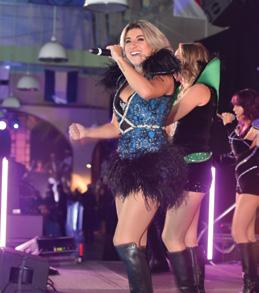

KAPI‘ L ANI
S O I R E E 2 0 1 9
Pier 11 at Aloha Tower proved to be the perfect port for the 2019 Soirée By The Sea, the signature gala benefit for Kapi‘olani Medical Center for Women & Children.
THE CRUISE LINE-THEMED EVENING featured sea creatures, couture-clad dancers greeting guests at the door, shuffleboard and elegant vintage décor. Dr. Alson Inaba, a Kapi‘olani pediatric emergency physician, set the tone for the boatload of fun with a CPR-inspired dance performance of lifesaving chest compression moves that even included a star backup dancer — Kapi‘olani CEO Martha Smith!
Proceeds from the event will support the future of heart care at Kapi‘olani through a new Pediatric Heart Center. Heart defects are the most common birth defect in the nation and Kapi‘olani wants to treat these babies at home. Kapi‘olani Health Foundation board members
Dr. Angela Pratt and Shelley Cramer served as the Soirée co-chairs, working with a team of community volunteers.
Generous contributions made the Soirée a success, including the commitments of title sponsor Saks Fifth Avenue, media sponsor Honolulu Star-Advertiser and 50 other individual, company and organization sponsors.

Steven Boyle Design transformed Pier 11 for the cruise line adventure.
Sea creature dancer greeted arriving guests.
Alter Ego dazzled with its 90 costume changes during performances that kept guests dancing all night long.
Aloha Inspire readers,
Hawai‘i Pacific Health patients are at the heart of everything we do. The patient experience and the medical center’s service to our communities are the meaningful motivation behind giving. In honor of this exceptional care, based on expertise and compassion, Inspire magazine has found its voice. Stories from grateful patients, dedicated medical staff and generous donors, inspire us and you.
Whether it’s a doctor who saved your life, a nurse who comforted your family or a staff member who extended themselves to help, we want to hear your story! Donations make a difference in action and inspiration.
We feel so fortunate to be an extension of the care at HPH by writing your stories. If you have a story to share, contact us at Foundations@HawaiiPacificHealth.org

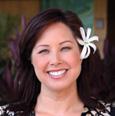
Liz Chun Uyehara Director of Foundation Communications

Nakashige Coordinator of Foundation Communications
Kelsey
